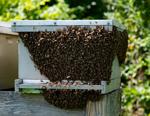Protecting Pollinators From Pesticides Important to Ag Economy
Protecting Pollinators From Pesticides Important to Ag Economy
Honeybees often come to mind first when the subject of protecting pollinators comes up.
The beloved insects produce hundreds of millions of dollars’ worth of honey in the U.S. annually, on top of their role as pollinators for some of our food crops.
However, honeybees represent only a fraction of the kinds of bees and other insects that pollinate crops, Patricia Prade told about 150 people at Penn State Extension’s Greenhouse Growers Day at Shady Maple on Jan. 22.
Prade, a Penn State Extension entomologist in horticulture, said there are about 4,500 species of bees in the U.S., about 560 of which can be found in Pennsylvania.

Patricia Prade talks about protecting pollinators at the Greenhouse Growers Day in East Earl on Jan. 22, 2025.
By contrast, there are only seven species of honeybees worldwide, and about half of U.S. honey sales are imports.
Insect pollinators besides bee species include flies, beetles and butterflies.
“I always like to say cockroaches are great pollinators,” Prade said.
Honeybees fall into the category of social bees, she said, and are less efficient at pollinating than solitary bees, which make up about 90% of all bee species.
Protecting all kinds of pollinators as well as honeybees from pesticides was the focus of Prade’s presentation.
“We depend on pollinators for our food,” Prade said. “They also have ecological significance.”
Pesticides are one of the four “P’s” contributing to the widely reported decline in pollinator populations, she said. The other causes are pathogens, pests and poor nutrition.
“Like insect pests, pollinators are susceptible to insecticides and other pesticides,” Prade said.
Pollinators can be exposed to pesticides through direct application or residue, or by ingesting sprayed pollen and nectar. They can also pick up pesticides in contaminated water.
Following label instructions and paying attention to spray timing are important measures for protecting pollinators.
“Time of application can be very critical,” Prade said. “Evening or night treatment is generally least harmful to bees.”
Growers should avoid spraying when plants are in bloom, as that’s when pollinators are most at risk.
Prade encouraged the use of integrated pest management tools that include diagnosing and monitoring insect problems as well as choosing low toxicity pesticides.
“Try to reduce the use of chemicals when you don’t need them,” she said.
Signs of pesticide exposure can be seen in disoriented bees that can’t fly and “appear drunk,” are not out foraging or are dead.
Checking the weather before spraying, minimizing spray drift by using low-pressure, low-drift nozzles, and communicating with neighbors are other good practices, Prade said.
Neighbors to notify about spray plans include beekeepers, other growers, and people who are registered as hypersensitive with the Pennsylvania Department of Agriculture.
“You have to work with your neighbors,” Prade said.
To find a map of beekeepers and people who are sensitive to pesticides in their area, growers with a valid pesticide license can log on the Pennsylvania Department of Agriculture website, click on Programs, and then select Hypersensitive/Apiary Search.


대화 참여하기